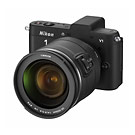 With the announcement of the Nikon 1 mirrorless camera system, the longest running rumor in the camera industry has been put to rest. Speculation about a Nikon EVIL camera (Electronic Viewfinder Interchangeable Lens) started even before Panasonic and Olympus announced their Micro Four Thirds system partnership in 2008. To start, there will be two Nikon 1 system cameras, the J1 and the V1. Performance-wise the Nikon J1 and V1 measure up well against their mirrorless / compact system camera competitors. Nikon claims their new “advanced hybrid autofocus system” is the fastest in the world and the cameras are capable of continuous auto focus shooting at 10 frames-per-second as well as the world’s fastest full-resolution shooting speed – 60 FPS with the focus locked. No camera is complete without HD video now so both the Nikon J1 and V1 can capture full HD video. The most interesting thing about the Nikon 1 cameras, however, is Nikon’s decision to use a 2.7x crop factor “CX” format sensor, smaller than all of the competition except for the Pentax Q, which uses a point-and-shoot sensor.
With the announcement of the Nikon 1 mirrorless camera system, the longest running rumor in the camera industry has been put to rest. Speculation about a Nikon EVIL camera (Electronic Viewfinder Interchangeable Lens) started even before Panasonic and Olympus announced their Micro Four Thirds system partnership in 2008. To start, there will be two Nikon 1 system cameras, the J1 and the V1. Performance-wise the Nikon J1 and V1 measure up well against their mirrorless / compact system camera competitors. Nikon claims their new “advanced hybrid autofocus system” is the fastest in the world and the cameras are capable of continuous auto focus shooting at 10 frames-per-second as well as the world’s fastest full-resolution shooting speed – 60 FPS with the focus locked. No camera is complete without HD video now so both the Nikon J1 and V1 can capture full HD video. The most interesting thing about the Nikon 1 cameras, however, is Nikon’s decision to use a 2.7x crop factor “CX” format sensor, smaller than all of the competition except for the Pentax Q, which uses a point-and-shoot sensor.
Update: We have a complete Nikon 1 J1 camera review on the site now. The J1 has solid image quality and outstanding auto focus performance. But don’t take my word for it. Check out the Nikon 1 image quality and performance for yourself, in our J1 review: Nikon 1 J1 Mirrorless Camera Pro Review >>
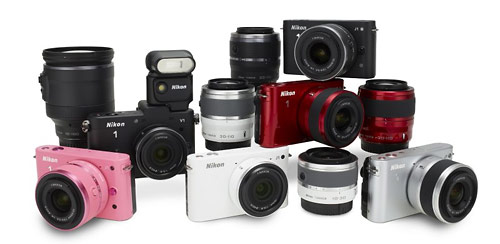
| “This Nikon 1 system represents a new category of camera that challenges conventional thinking, emphasizing a pocketable form factor with unbelievable speed, combined with the high image quality that only Nikon could create.” |
Nikon 1 System Key Features and Specs:
- 10.1 megapixel High-Speed AF CX-format CMOS sensor
- New Expeed 3 image processing
- 1080p full HD video with 30/60/400 and 1200 FPS options and built-in stereo sound
- New hybrid auto focus (phase detect + contrast detect) is world’s fastest
- New Nikon 1 lens mount
- 3-inch LCD display (460k-dot for J1 / 921k-dot for V1)
- 1.4 million dot high resolution EVF (V1)
- ISO 100-3200 expandable to ISO 6400 (Hi-1)
- Pop-up flash (J1)
- Accessory shoe (V1)
- 10 FPS continuous AF burst and 60 FPS with focus locked
- JPEG, NEF RAW, NEF RAW + JPEG
- Simultaneous still and video capture
- New Motion Snapshot mode
- Smart Photo Selector mode
Size-wise, the Nikon J1 and V1 are closer to pocket cameras than most compact system cameras. With the wafer-thin 1 Nikkor 10mm f/2.8 pancake lens, the smaller J1 (4.2 x 2.4 x 1.2 in / 106mm x 61mm x 29.8mm) looks like it might really be “pocketable.” The more advanced V1 is a little larger, mostly because it has a built-in 1.4-million-dot electronic viewfinder (EVF). Both cameras share very competitive high-performance specs, namely, full HD video, a new “hybrid” auto focus system and the new 10-megapixel CX-format CMOS sensor. The new sensor has a 2.7x crop factor and the dimensions are 13.2mm x 8.8mm, which means it falls between the Panasonic / Olympus Four Thirds sensors and the largest compact camera sensors. There is going to be a lot of argument and speculation about the image quality since the sensor is considerably smaller than the Four Thirds and APS-C sensors in the Panasonic, Olympus, Sony and Samsung compact system cameras. However, Nikon has been the digital SLR image quality leader for a few years so they’ve got a few tricks up their sleeve. They wisely decided to keep the resolution at a conservative 10-megapixels, which, along with the brand new Expeed 3 processing system, should ensure good image quality with low noise. I will be surprised if the image quality isn’t at least as good as the Olympus and Panasonic and Olympus Micro Four Thirds cameras but I wouldn’t expect it to be as good as Sony’s NEX cameras. We’ll have to wait and see to know for sure, though. As far as I know there aren’t any Nikon 1 sample images on the Web yet, so we’re just guessing right now.
Nikon’s new Expeed 3 processing is arguably the most impressive feature of the new cameras since it delivers shooting speeds as fast as 60 frames-per-second for full resolution stills and 1920 x 1080/60i full HD slow motion video and even super slow-mo at 1200 frames-per-second (320 x 120). The J1 and V1 can also simultaneously capture a still photo and video with one push of the shutter release button. Combine the processor speed with the new hybrid auto focus and you get 10 frames-per-second bursts with continuous auto focus – that’s faster than Nikon’s D3s professional digital SLR! With that kind of performance, I expect we’re going to see a lot of backcountry, travel and action sports photographers lining up for the Nikon V1 and J1.
There are a couple of interesting new shooting modes on the J1 and V1. The new Motion Snapshot feature takes advantage of the still / video capability and merges, “a frozen still image with a slow-motion movement set to a built-in audio soundtrack to create a portrayal of an occurrence with maximum impact.” I need to see this to really judge it. It could just be cheesy. But I’m definitely curious and it sounds like a great feature for families and casual snapshot photographers. The Smart Photo Selector mode uses the camera’s cache to keep a running burst of photos and then the camera chooses the best of the bunch for you. Nikon says it’s for ‘”can’t miss”‘ opportunities when you don’t want to risk blowing it. Just let the camera take care of it for you – even the photo selection.
The Nikon V1 is the more sophisticated of the two new cameras. It has a magnesium alloy chassis, a 1.4-million-dot electronic viewfinder, a 3-inch 921k-dot LCD display, an accessory port for the new SB-N5 Speedlight and GP-N100 GPS, a mechanical shutter with a pro-level 1/250th second flash sync and a 350-shot battery. The Nikon J1 doesn’t have an EVF or an accessory port, it has a lower-resolution 460k-dot 3-inch LCD display and the battery is only rated for 250 shots. It has an electronic shutter with a much slower 1/60th of a second flash sync but it does have a built-in pop-up flash. Why would you want a J1 instead of a V1? The J1 is smaller and lighter and it costs $250 less than the V1. They both share the same sensor, processing, auto focus and video specs so basic performance and quality will be the same regardless of which camera you buy.
This being an all new format and lens mount, Nikon announced four new lenses: the 1 Nikkor VR 10-30mm f/3.5-5.6 lens (27-81mm equiv.), 1 Nikkor VR 30-110mm f/3.8-5.6 lens (81-297mm equiv.), 1 NIKKOR 10mm f/2.8 pancake lens (27mm equiv.) and 1 Nikkor VR 10-100mm f/4.5-5.6 (27-270mm equivalent) power zoom lens1 Nikkor 10mm f/2.8 pancake lens (27mm equivalent) and 1 Nikkor VR 10-100mm f/4.5-5.6 (27-270mm equivalent) power zoom lens. The 1 Nikkor lenses use a new Silent Stepping Motor (STM), “for whisper quiet AF and zoom during operation and while shooting movies.” Note that the three zoom lenses use Nikon’s VR II optical image stabilization to help keep photos sharp in low light. There’s also an FT-1 F-mount adaptor planned so you can use your Nikon SLR lenses with the Nikon 1 cameras.
The Nikon V1 and J1 cameras are scheduled to be in stores and online dealers on October 20th for $899.95 and $649.95, respectively. That price includes the 10-30mm f/3.5-5.6 VR kit lens. The 10mm f/2.8 pancake lens and VR 30-110mm f/3.8-5.6 zoom lens will both sell for $249.95 and the Nikkor VR 10-100mm f/4.5-5.6 power zoom will sell for $749.95.
Nikon 1 J1 Review >>
Nikon 1 System Press Release >>
Related Content:
All Nikon User Reviews
All Compact System Camera User Reviews
Nikon Cameras Forum
EVIL & Micro Four Thirds Cameras Forum
All EVIL Cameras News & Articles
All Nikon News & Articles
Nikon Web Site
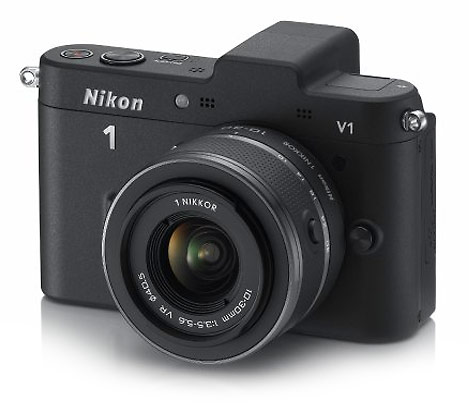
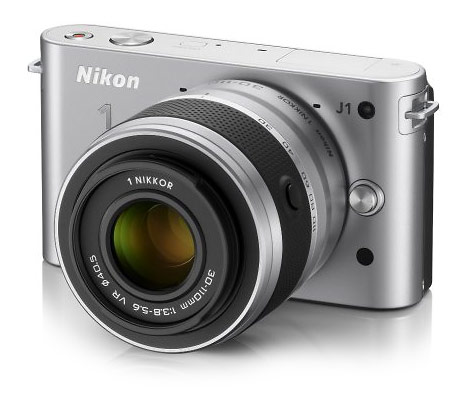
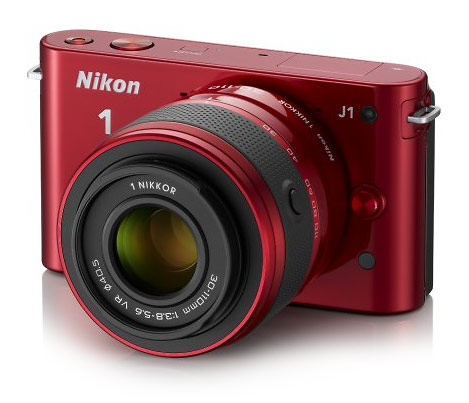
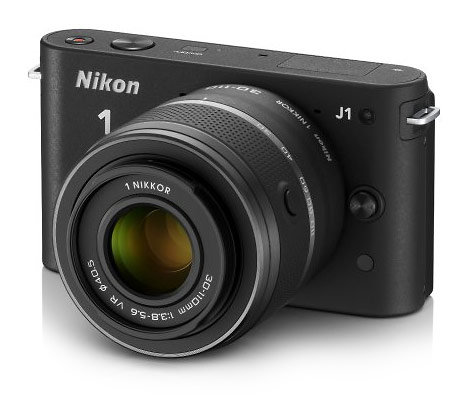
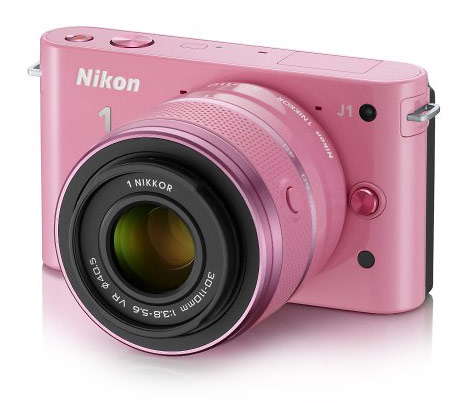


Looks like dpreview posted some Nikon J1 sample photos last night. They look really good – better than I would have expected. The ISO 3200 samples are especially impressive. You can see them here: http://www.dpreview.com/news/1109/11092210nikonj1samplesgallery.asp
Feature-wise, it’s pretty slick. But the sensor size means really difficult to achieve DOF effects. Makes the same-size NEX system with its 4x larger sensor seem that much more impressive.
Good point, Sebastian. I hadn’t thought about that. Olympus and Panasonic have done a decent job of coming out with fast aperture Micro Four Thirds lenses that make depth-of-field control possible, although they could use some fast zooms. For video, the smaller sensor may actually be a bonus because more depth-of-field gives you padding if the continuous auto focus isn’t up to speed. That’s one reason I like shooting video with the Micro Four Thirds cameras – the smaller sensor gives me a cushion so I’m less likely to get out-of-focus clips.
I believe that the lack of shallow dof you get with the smaller cameras is more a function of the smaller glass, rather than the small sensor. It is, after all, an optical effect. If that’s the case, then mounting a ‘full size’ SLR lens on the camera, via the mentioned f-mount adapter, should give you plenty of dof control. I’ll need to test it out, of course, to verify that, but it should be interesting.
I am amazed at the amount of negative comments this Nikon model release has garnered on the dpreview website.
For a camera that has yet to be released to the public, the amount of hostility and criticism are remarkable.
Herein are my personal observations based on what is currently shown and available out there (I have yet to get my hands on the item and test it myself).
1. People equate bigger sensors to higher quality. Nikon is trying to convince the buyers, it isn’t so. Good luck.
2. People want to see and hold a beautiful chunk of art called a camera to wear as a necklace. Nikon says, simple is better. So the shape of the new Nikon 1 is so simple and similar to all existing shapes, sizes and coloured cameras currently on the shelves, it will justl merge with the crowd. In fact, Nikon made it so simple, the J1 doesn’t have any unique and outstanding feature… except being ultra simple. To be able to stand out from among the same looking crowd, the price range has been set to a different strata. That would surely raise some eyebrows, but not wallets.
3. The technical design is brilliant, on paper. It has yet to be proven by use and feed back reviews.
On a personal note, I am having a blast using my legacy Nikkor AI lenses on the new Micro 4/3 camera bodies.
With just a simple and cheap AI to M4/3 adapter, my Manual Focus Nikon lenses came back to life again.
Photography review is a great site and more power to you, John!
Keep on truckin’!
AR
The Nikon Looks OK–nothing special though. IQ is OK, styling is OK. Lens choice looks awful though. Too expensive and two years too late. — Im glad ive gone with the Micro four thirds system with its excellent lens choices and two companies to choose from.
For that kind of money just buy a regular Nikon digital slr
Biggest thing for me is the arkwardness of holding this camera
There is no base to it and no real grip
just my 2 cents
Should I get a Nikon 1 or should I upgrade my Nikon D5000 to a Nikon D7000?
That’s a damn good question, Francois. The Nikon J1 and V1 aren’t replacements for a full digital SLR. But if size and weight are a consideration, then the new Nikon 1 cameras may be a better choice. The compromise you’ll be making with the Nikon J1 and V1 are image quality and probably also auto focus performance. That could be a fair trade, however, if you want to take the camera out on your mountain bike or use it for an unobtrusive walk-around camera. The jury is still out on overall performance compared to other compact system cameras like the Sony NEX and the Micro Four Thirds cameras. It appears that the advantage of the Nikon 1 cameras compared to other compact system cameras may be auto focus performance. The Nikon J1 and V1 have a new “hybrid” phase detect / contrast detect system that purports to offer the best of both the EVIL camera and the digital SLR worlds.
So, to answer your question in a more succinct way – don’t replace your D5000 with a Nikon 1 camera. But if you want to add a second, smaller camea to your system, then the Nikon 1 looks pretty good. You should take a careful look at the Sony, Olympus and Panasonic options as well, though.
That’s awesome John!
I really like that the Nikon 1 can take photos while shooting Hi Res video. That is a big loss for us as we can’t have photos while taking action videos. Do any of the competitors do that?
Is there a comparison of the popular competitors for this camera? What are the model names?